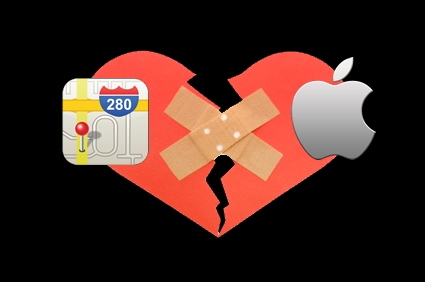By now most of us have heard the story of late Apple founder Steve Jobs declaring “thermonuclear war” on Google’s Android operating system. That war, it seems, is in full effect on multiple fronts. Of course, there is Apple’s recent patent infringement victory over Samsung in court (a decision that could have multi-billion dollar implications), and now, with the release of iOS 6, Apple has effectively dumped Google Maps from the iPhone. While the narrative has largely become the multitude of problems that the new Apple maps application is causing for users (take a look here for some fun observations on that), the story of the shift away from Google Maps itself is a big deal.
We’ll get to some of the numbers in a minute, but first, let’s consider the statement this move makes. The use of Google Maps has been central to the operation of the iPhone since its inception five years ago. You’ll no doubt remember those iconic iPhone commercials that showed how elegantly you could find information with this magical new device. Those spots included a whole lot of air time for the Google Maps application that came loaded on the phone. Now, not only has Apple replaced Google Maps with its own as the default, users can’t even download and use the Google Maps application after upgrading to iOS 6.

Now, you may say that Google is still well-positioned because of the Android operating system’s 68% worldwide share of the smartphone market, compared to just 17% for the iPhone. Think again. While Android may have a majority market share in terms of the number of smartphones on the market, Apple enjoys a 66% share of total mobile web browsing (this includes tablet, where the market share for Apple’s iPad is beyond dominant). This means that the majority of mobile web browsing is happening within iOS, and that means trouble for Google Maps.
Let’s follow the logic from Google’s perspective. The biggest growth area for search is mobile. Mobile search is about 50% more likely to be local in nature than desktop. Google Maps is Google’s big local play. The biggest player in mobile has essentially blocked Google Maps from its devices. That’s not good for Google, and it’s also not good for businesses that have spent all of their time optimising local business listing information only on Google Maps.
As you might imagine, Google is not taking this lying down. They’ve already announced some enhancements to Google Maps, and there’s word that they might try to release a standalone Google Maps application for iOS. Here, Google is leaning on the superiority of their product. The problems that Apple has run into with the early release of its maps application demonstrate that Google’s multi-year head start in the space is, in fact, a meaningful advantage. Google’s goal is no doubt to create demand that will both encourage people to choose the more open Android platform and to demand that Apple offer Google Maps as an option on iOS devices (if not to revert to making it the default maps application). The folks at Google must be deriving some satisfaction from the bad press Apple maps has gotten so far. While the interface (as you would expect) is very slick, the experience of actually using it to find stuff has largely disappointed. I experienced this myself when I fired up my newly updated iPhone 4S and tried to use the new turn-by-turn functionality in iOS 6 to get me to work. When it wanted to take me to somewhere in the middle of Kansas, I decided to go from memory instead.
Regardless of how Apple’s war on Google plays out in the long term (you can bet that Apple is working overtime to address the shortcomings of the maps applications), there can be no doubt that businesses need to be concerned about more than Google Maps when thinking about their local listing data. Distributing local data to a broad range of providers has never been more important. The new Apple maps application gets its data from a whole bunch of different sources, so simply claiming your listing on Google is not going to cut it (not that it ever really did). Apple may have stumbled out of the gate here, but there’s no doubt that their maps application will improve and realise a lot of the mobile market share in the near and longer term. As such, getting listing information right in this new channel simply cannot be neglected. Businesses with a broader approach to the space are sure to be rewarded for their efforts.
Interested in finding out more? Contact DAC today.



